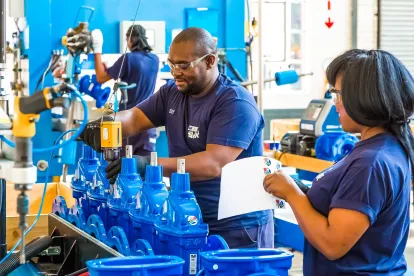As employee retention issues and the “great resignation” make headlines, the manufacturing industry not only feels the pressure of a tight labor market in 2022, but also faces additional labor challenges. Despite signs earlier in the year that the COVID pandemic was waning, it continues to impact employers’ ability to remain fully staffed. Employers continue to face a changing and complex landscape with respect to continued remote work, labor shortages, and COVID-protocol-related accommodation requests. However, COVID matters are not the only key issues facing employers in the manufacturing industry this year. Changes to the National Labor Relations Board (NLRB or Board) and its general counsel in 2021 mean that unionized and nonunionized employers will face challenges in the traditional labor arena as well.
1. COVID, COVID, COVID — As Cases Begin to Increase Again, Employment Related Challenges Continue in 2022
A. Remote Workforce Issues
Through the surges and slowdowns of COVID cases during the course of the pandemic, one pandemic-related change seems here to stay: a greater number of workers are working remotely. While some businesses are encouraging workers to come back to the office, others have enhanced remote work opportunities and face the challenges associated with a fully or partially remote workforce. Employers should take care to consider the legal implications of this change. If an employer now has employees working remotely in states where it previously did not have operations, there may be tax and other implications. Generally the laws of the state where an employee works will govern the employee’s employment. If employees are working in a new state or locality, employers should ensure they are up-to-date on and mindful of those state and local laws that may differ from other locations where the employer operates. Are there local sick leave laws? Changes to enforcement of non-compete agreements? Requirements for reimbursement of expenses? Careful consideration of local employment laws and regulations can prevent costly missteps.
B. Labor Shortage Pain - Difficulties in Hiring and Retention
Many employers are also currently facing an extreme labor shortage that has not only impacted hiring, but also retention of employees. In order to entice applicants and encourage employees to remain with the company, many manufacturing employers have increased financial and other incentives. Signing bonuses, attendance bonuses, and other financial incentives can be an effective means to recruit and retain talent. In doing so, manufacturing employers (who often have a large number of non-exempt workers) should be knowledgeable of the various wage-and-hour requirements to avoid any risk of unpaid wage or other claims. Employers should carefully consider whether the incentives they implement should be factored into the regular rate when calculating overtime. Likewise, employers should ensure that such incentives are consistently and fairly implemented.
C. Accommodation Requests for COVID Protocols
Since the outset of the pandemic, employers have had to contend with various requests for accommodation relating to COVID protocols, whether related to mask requirements, vaccine mandates, or leave issues.
As an initial matter, employers should be aware that COVID can be a disability under the ADA, depending on the employee’s symptoms. If an employee requests leave for COVID-related symptoms, beyond what is typically granted by company policy, employers should involve legal counsel to determine on a case-by-case basis whether it may be considered a disability that would require the company to engage in the interactive process.
Even if an employee does not test positive for COVID, employers may receive requests for accommodation due to a disability or religion that prohibits the employees from complying with COVID-related protocols. Many employers are familiar with this issue if they have a mask policy or vaccine policy. Employers should engage in the interactive process in such cases, in order to determine whether a reasonable accommodation can be granted that does not impose an undue burden on the company.
To the extent employers are permitting some employees to work from home, it is wise to make sure that decisions are made on a consistent basis and are based on the employees’ job duties. In a manufacturing environment, where at least some portion of the employee population likely has to be physically present in the workplace, remote-work decisions based on concrete job requirements will help to avoid future claims of unfair treatment.

2. Increased Union Activity to be Fueled by Changes to NLRB Standards and Priorities
COVID-related matters are not the only key issues facing employers in the manufacturing industry in “the coming year. We have already seen some diversions from the Trump-era labor board. As such, changes to NLRB standards and priorities will continue to affect unionized and nonunionized employers through 2022 and beyond.
In a striking example of the coming changes in the traditional labor space, on April 7, 2022, NLRB General Counsel Abruzzo issued GC-Memo 2204, which describes her position with respect to employers’ so-called “captive audience meetings”: mandatory meetings held by the employer in which it gives its position regarding union organizing. The meetings have long been permitted under Board interpretation of the NLRA. Abruzzo’s position, as described in the memo, would represent a dramatic shift in longstanding Board precedent. Abruzzo’s position is that the meetings “inherently involve an unlawful threat that employees will be disciplined or suffer other reprisals if they exercise their protected right not to listen to such speech.” She plans to urge the Board to reconsider its precedent and find mandatory meetings of this sort unlawful, because she believes the current precedent “is at odds with fundamental labor-law principles, our statutory language, and our congressional mandate.” The meetings have historically been an important tool for employers to get their message out to employees during a union-organizing campaign. If the Board does, in fact, overturn the precedent, employers will be challenged to find other ways to communicate with employees during a union campaign that are permitted under the NLRA.
Last year, on July 22, 2021, NLRB General Counsel Jennifer Abruzzo issued her first memo, which set her agenda and priorities for her four-year term. In addition, with various terms expiring and resultant Democratic nominations submitted for consideration, the Board itself has also changed from a Republican to a Democratic majority, led by Chairman Lauren McFerran. Not surprisingly, the memo and Democratic majority on the Board mark a significant change in priorities from the Trump-era NLRB to a more union- and employee-friendly stance. The following potential changes in standards and priorities of the NLRB are anticipated:
A. Closer Scrutiny Involving Employee Handbooks
The NLRB is likely to increase scrutiny of employee handbook provisions that may be construed to restrict activities protected under Section 7 of the National Labor Relations Act (NLRA). Under the Trump-era Board, the NLRB had adopted the Boeing test with respect to employee handbooks. This test assessed a facially neutral handbook policy by balancing the alleged restrictions against the employer’s legitimate justifications for implementing the policy. The test was much more flexible and employer-friendly than the previous standard under the Lutheran Heritage case, which prohibited any handbook policy, including those that did not explicitly prohibit protected activities, if the rule could be “reasonably construed” by an employee to restrict such activities. At the time, the Board viewed such rules to have a chilling effect on protected activities and thus considered them a violation of the NLRA. The Boeing case is specifically referenced in the general counsel’s August 12, 2021 memo as a case “involving board doctrinal shifts” that upended prior precedent that “struck an appropriate balance between the rights of workers and the obligations of unions and employers.” This shows that the general counsel, and very likely the Board, are poised to return to the more employee-friendly Lutheran Heritage precedent. In anticipation of this change, employers should review their handbooks for possibly problematic policies and be ready to change such policies if the Board issues a decision overruling the employer-friendly Boeing standard.
B. Possible Increased Application of Weingarten Rights
As unionized employers know, Weingarten rights are the rights of represented employees to have union representation present when requested at an investigatory interview that may lead to discipline. Under current Board precedent, Weingarten rights only exist in a union environment. Specifically in 2017, the Board declined to extend Weingarten rights to an employee who was not represented by a union, but who had requested to have a co-worker present during a disciplinary interview. Over the years, the Board has changed its position on a few occasions regarding whether nonunion employees have the right to request representation during investigatory interviews. In 2000, the Board had held that nonunion employees did have a right to such representation but then changed its stance in 2004. The general counsel memo references the current Board precedent, which does not extend the right to nonunion employees, as an “area or initiative” bearing reexamination. Employers should watch for Board changes in this area and make sure its human resources employees and others conducting such interviews are up-to-date on any changes with respect to whether nonunion employees are entitled to representation upon request.
C. Access to Employer Property for Unionizing Purposes
Another area where nonunionized employers should be aware of potential change in Board precedent is with respect to union organizers’ access to, and use of, the employer’s property. Under the current state of the law, pursuant to Tobin Centerfor the Performing Arts, an employer is permitted to exclude off-duty contractors from the nonpublic areas of its property even when they seek to engage in Section 7-protected activity unless the contractors (1) work regularly and exclusively on the property, and (2) the employer fails to show that the contractor has one or more reasonably non-trespassory alternative means of communication (meaning they do not require using the employer’s property). Under the UPMC case, which is current Board precedent, employers have the right to refuse union access to even public spaces on an employer’s property.
Under the new Board, the state of the law is likely to return to the New York New York Hotel and Casino standard, under which employers could not restrict off-duty employees from using non-work areas to distribute pro-union literature. Similarly, the UPMC standard is likely to be overturned in favor of the prior Sandusky Mall standard, under which employers could not restrict a union from using public spaces on an employer’s property for union organizing activity if the employer permitted other commercial, civil, and charitable activities in that space. Close scrutiny by employers of the current Board precedent, and changes in this area, is advised where the company is facing union organizing activities in order to avoid the filing of an unfair labor practice charge and possible implementation of a bargaining order.
D. Expansion of Interpretation of Protected Concerted Activity
Employers can also expect an expanded interpretation of Section 7 “protected concerted activities” under the new Board and general counsel. This may include expanded rights of employees to use their employer’s communication systems for protected activity. The general counsel memo specifically identifies cases in which an employee’s right to use the company email system (or other company communication systems such as Discord, Slack, or Groupme) for protected workplace communication should be given special attention. The memo identifies the current Board precedent as involving “Board Doctrinal Shifts” (from the prior Purple Communications standard, which held that employers must permit their employees to use company email systems to engage in protected activity to the current Rio All-Suites Hotel and Casino, which overruled Purple Communications and permits employers to restrict such employee email communications). The general counsel memo also identifies current board precedent that narrowed the scope of protected activity as requiring reexamination. Specifically it references current Board precedent that employees who acted on behalf of interns were not engaged in protected activity because it was not for “mutual aid and protection.”
This signals that the general counsel and Board will seek to expand the definition of “mutual aid and protection” and thereby the definition of protected concerted activities. With these and other related examples, employers can expect a return to an expanded view of protected concerted activities, which will restrict the actions employers can take with respect to such activities even if the actions are impermissible under current law.
These are just some of the examples of changing precedent from the NLRB that are likely to affect unionized and nonunionized employers alike. The changes are all union-friendly and likely to help fuel increased union activity in the coming years. As with the quickly changing legal environment respecting COVID related issues, manufacturing employers should stay up to date on new decisions from the NLRB (and be aware of enforcement priorities of the general counsel) to avoid labor-related liability in 2022 and beyond.
As these examples highlight, manufacturing employers face unique challenges in 2022 due to a frequently changing legal landscape. Employers should be vigilant regarding updates to the current state of the law in these and other areas.






 />i
/>i
